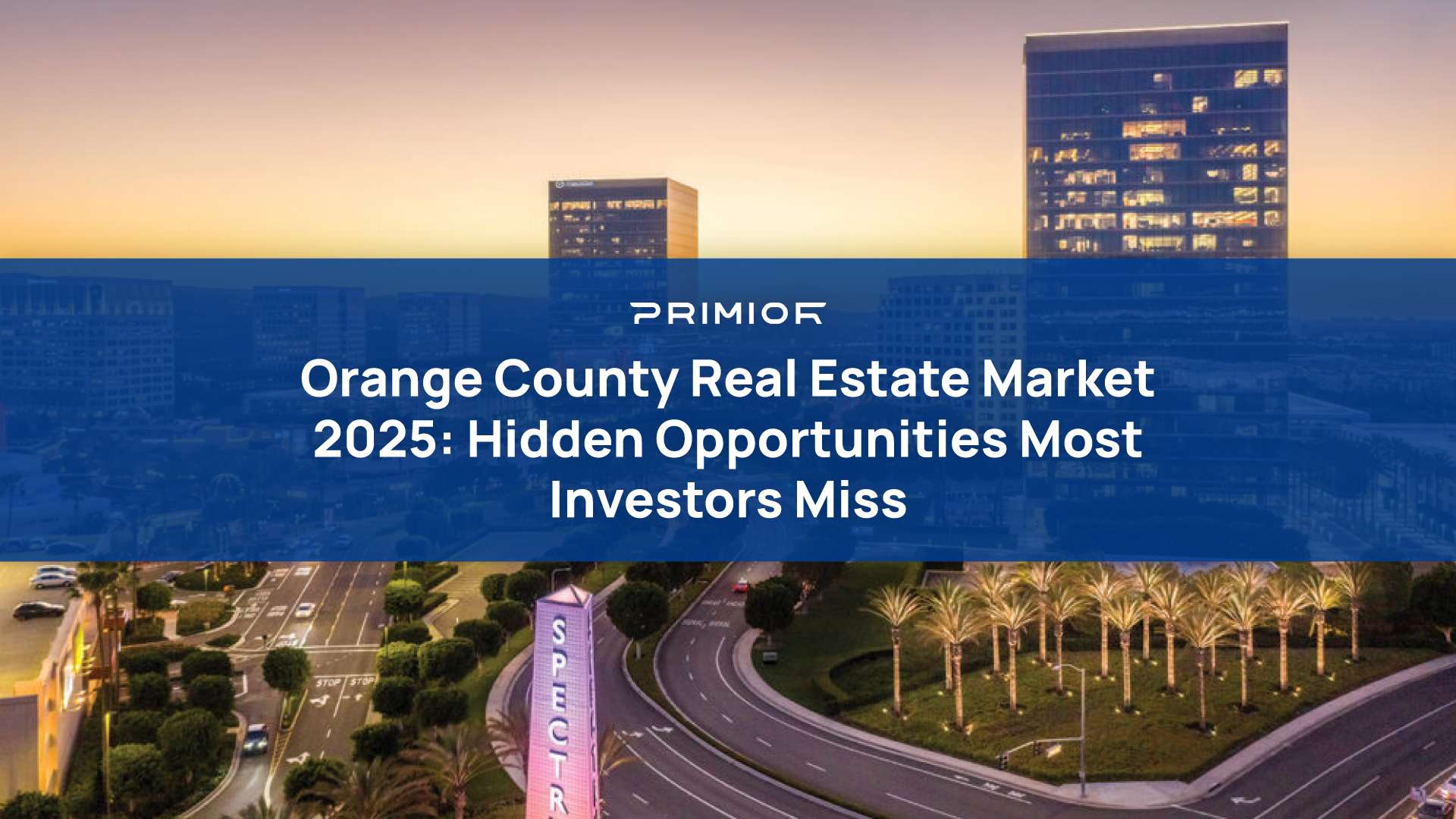The Orange County real estate market shows impressive strength as median listing prices climb to $1.3 million in late 2024, up 4% from last year. Properties sell quickly within 48 days of listing, even with mortgage rates between 6-7%.
Smart investors look beyond obvious choices because the market offers many more paths to success. The California Association of Realtors expects median home prices to rise 4.6% in 2025. Limited inventory and steady buyer interest support this growth. The luxury segment shines especially when you have affluent buyers seeking coastal properties and exclusive gated communities.
This detailed guide explores hidden gems in Orange County’s digital world, from up-and-coming neighborhoods to different property types. These insights help investors make smart choices in this evolving market.
Current State of Orange County Real Estate
“The Orange County housing market is particularly rate-sensitive. As mortgage rates migrate higher, demand slows, and the market speed slows. When rates fall, demand rises, and the housing market speeds up.” — Doug Echelberger, Founder of Echelberger Group
Sales activity in the Orange County real estate market shows amazing momentum. Detached homes saw a 33.3% surge in sales volume compared to the previous year. On top of that, attached homes showed strong performance with a 9.5% increase in sales.
Market performance in Q1 2025
Q1 2025 paints an interesting market picture. The Expected Market Time sits at 76 days, suggesting steady market activity. The inventory levels hit 2,401 homes – the third-lowest start to a year since 2004. The market keeps a balanced position as homes sell at a steady pace.
Key price trends by neighborhood
Orange County’s neighborhoods show different price patterns. Detached homes reached a median sales price of $1,376,389, with a substantial 5.9% increase year-over-year. Attached homes saw a slight shift with a median price of $745,000, showing a small 0.7% decrease.
The luxury market in Newport Beach and Laguna Beach stays strong. These prominent neighborhoods make up 33% of inventory but represent 16% of demand. Luxury properties have an Expected Market Time of 157 days, which creates opportunities for strategic investors.
Supply and demand dynamics
The market shows fascinating supply-demand patterns. Both attached and detached properties have an inventory of 2.4 months. Sellers still have the advantage as homes move quickly off the market. Here’s how it breaks down:
- Attached homes take 29 days to sell
- Detached properties sell within 32 days
- The market absorption rate points to strong buyer activity
Buyer interest stays strong with 1,756 properties under contract – up from previous weeks. The average Days On Market dropped to 58, with a median of 28 days. This shows robust demand for well-priced properties.
This market creates unique opportunities for investors who know local dynamics. Strategic buyers can find good entry points through steady price appreciation in specific neighborhoods and varying demand levels across property types.
Emerging Neighborhood Opportunities
Orange County has several up-and-coming neighborhoods that smart investors should check out. Costa Mesa stands out because it blends suburban comfort with urban amenities. The area boasts a thriving arts scene and sits close to major job hubs.
Up-and-coming areas with growth potential
Lake Forest has become a hot spot for investors with its peaceful lakes and excellent recreational facilities. Stanton catches the eye through its city makeover efforts and budget-friendly housing options. The “City of Trees,” Tustin, gives easy access to major freeways from its central location.
These areas show strong market performance with vacancy rates at 4%, which is by a lot lower than the national average of 5.6%. Class B and C properties have done exceptionally well, showing a tiny vacancy rate of 2.6%.
Each emerging neighborhood brings something special to the table:
- Garden Grove: Rich cultural mix and diverse housing choices
- Placentia: Great schools and active redevelopment projects
- Huntington Beach: Steady growth with strong buyer interest
Infrastructure development effect
Orange County’s emerging neighborhoods are growing faster thanks to big infrastructure investments. The county put $160 million into upgrading infrastructure over seven years. These improvements help many communities.
The new infrastructure includes better transportation, like the OC Streetcar project that connects existing rail and bus routes. This smart transportation solution helps boost property values in nearby areas by making everything more accessible.
Areas with good road systems and modern facilities attract more residents and businesses naturally. New public transportation and expanding commercial centers push property values up.
Big companies like Ingram Micro, Broadcom, and Western Digital have made Orange County their home. Irvine brings in tech companies like VIZIO and Linksys. These companies create jobs that drive housing demand in nearby growing neighborhoods.
Infrastructure improvements go beyond just transportation. They include new waste management systems and better school facilities. These upgrades make communities more attractive and help property values grow over time. Regular upkeep and updates help avoid repairs that can get pricey while funding other community needs.
Off-Market Investment Strategies
Smart investors know that off-market properties create the best opportunities in Orange County’s competitive market. These properties sell privately without public listings and give buyers exclusive deals with unique advantages.
Finding pocket listings
Pocket listings make up a unique segment of off-market properties where homes sell privately through select realtor networks. Buyers face less competition and get more time to make thoughtful decisions with these exclusive listings. Most homeowners choose this path to keep their privacy and retain control over the sale process. They only deal with serious buyers who have strong local representation.
Building broker relationships
Professional networking is the life-blood of getting access to off-market deals. Smart investors create connections with real estate professionals of all types, from homeowners to developers and agents. These relationships help them see properties before they appear on public platforms.
Key networking strategies include:
- Attending industry events and local functions
- Joining professional associations
- Staying active in local real estate communities
- Following up with new contacts
- Creating relationships with vendors and contractors
Direct mail campaigns
Direct mail campaigns help uncover hidden opportunities. Investors can find potential sellers who haven’t thought about listing their properties through well-crafted marketing materials. The best campaigns need exact targeting and demographic analysis to get maximum responses.
Direct mail strategies work best with a personal touch and regular follow-ups. Investors who stay in touch through targeted mailings often see properties first, before they reach the market. This approach works especially when you have established neighborhoods where homeowners might sell but haven’t taken steps yet.
Investors should build detailed databases of potential sellers and stay connected through different communication channels to get results. Digital platforms combined with traditional mail campaigns can boost reach and success.
These strategic approaches help investors access exclusive opportunities before they become accessible to more people. Success in off-market acquisitions comes from mixing multiple strategies – from growing broker relationships to running targeted marketing campaigns.
Value-Add Property Opportunities
Undervalued properties in the Orange County real estate market need a sharp eye and smart strategy to find them. We spotted these hidden gems in properties that sit on the market longer than usual or need some fixing up.
Identifying undervalued assets
Smart investors target properties priced below their true value, which helps them profit through appreciation or rental income. The best buyers skip the obvious deals and look for these telltale signs:
- Properties that need cosmetic updates
- Homes sitting too long on the market
- Tax-delinquent properties
- Properties with cheaper price per square foot
- Older or remote properties ready for updates
Smart buyers analyze growth patterns in their target neighborhoods before making investment decisions. Auction properties might be risky but give you a chance to buy below market value. You can get properties at tax sales for much less than their actual worth.
Renovation potential assessment
A full picture of repair costs and the property’s after-repair value (ARV) helps you understand renovation potential. The first phase of whole-home renovations usually reveals 20-30% of big challenges and surprises.
Your assessment should put structural elements ahead of pretty improvements. Investors must focus on:
Structural upgrades bring great returns, especially with HVAC systems, new siding, and electrical work. Kitchens and bathrooms give you the best return on investment by balancing looks and function.
Your renovation budget should set aside 10-25% for surprise issues, whether you plan small updates or big changes. Properties that need lots of work often sell cheap, which lets you profit nicely through smart improvements.
Building permits and local rules matter when you plan renovations. New construction or big changes without proper permits can affect your property taxes and create legal headaches. Regular maintenance and repairs usually don’t bump up your taxable value.
Your renovation plan should match what the neighborhood expects and what buyers want. Properties in popular rental areas might do better with improvements that attract long-term tenants. Some renovations cost a lot but pay off well when you plan them right.
Alternative Property Types
Alternative property investments offer compelling chances in Orange County’s changing real estate market. Investment funds can now put up to 50% of their portfolios into alternative property types. This includes 25% in non-core properties and 25% in new subtypes.
Mixed-use developments
Mixed-use projects are changing Orange County’s property landscape because people want integrated living spaces. Santa Ana showcases this trend with a USD 3 billion development. The project covers 41 acres and includes 3,750 apartments, 200 senior housing units, 250 hotel keys, and 350,000 square feet of retail space.
This revolutionary project shows amazing results:
- USD 500 million in net revenue over 30 years
- USD 544 million in community benefits
- 16,800 new jobs that create USD 1.5 billion in citywide labor income
Developers are quick to adapt to market changes. The Irvine Company plans to add 1,250 apartments to its Market Place mall and replace 200,000 square feet of retail space. This trend goes beyond Irvine. Similar redevelopment plans are in the works for Block at Orange, Brea Mall, MainPlace Mall, Westminster Mall, and Laguna Hills Mall.
Small multi-family units
Small multi-family properties show strong investment potential in Orange County. Recent market activity proves high demand – three properties with 18 units sold for USD 5.40 million. These properties come with attractive features:
An eight-unit, two-building apartment property in Anaheim sold for USD 2.60 million – that’s USD 325,000 per unit. A six-unit property at East Chestnut Avenue went for USD 1.30 million, which works out to USD 208,333 per unit.
Small multi-family investments are attractive for several reasons:
- Strong rental housing demand
- Attractive capitalization rates
- Consistent rent growth potential
- Central locations near amenities
- Individually metered utilities
Alternative housing sectors like seniors housing, single-family rentals, and manufactured housing are growing fast. Properties with live-work flexibility have become more popular. Many new condos and townhomes now feature first-floor flex rooms that work well as home offices.
Orange County’s development pipeline stays active with about 8,300 units under construction. Santa Ana and South Orange County led recent development, but Irvine now leads with 5,300 units in progress. Volar, a notable project, will add 876 upscale apartments by late 2024.
Risk Management Strategies
Risk management is the life-blood of successful real estate investment in Orange County’s dynamic market. Smart investors review market cycles and put strong exit strategies in place to protect their investments.
Market cycle positioning
The timing of investments depends on Orange County’s position in the real estate cycle. Orange County and San Diego now rank as the strongest markets nationwide, with Very Strong ratings based on new home sales and pricing conditions. These markets thrive due to extremely low new and resale supply, which keeps prices up and drives sales for available properties.
Several key indicators show the local market’s remarkable strength:
- Economic stability with diverse industries
- Steady demand from high-income households
- Relatively low interest rates compared to historical standards
- Persistent inventory constraints
We noticed that Orange County operates in the Growing/Maturing phase of the market cycle. This phase shows rising volumes and prices, substantial home price appreciation and robust job growth. The market has picked up on international buyer demand, which bounced back despite domestic household out-migration.
Market timing is vital since interest rate changes can substantially affect purchasing power. Investors should keep track of several critical factors:
Interest rates now move between 6.5% and 7%, which shapes buyer activity and market dynamics. The inventory reaches about 4,700 homes, higher than 2024 but still well below pre-pandemic levels. Home values could rise 3% to 6% under current conditions.
Exit strategy planning
A winning exit strategy needs detailed planning and thought. Investors should do thorough due diligence by checking financial statements, property conditions, and location dynamics. This approach helps lower risk exposure and boost potential returns.
Exit strategies work best when they account for different market scenarios. Good conditions with mortgage rates at 6-6.5% might keep inventory around 4,000 homes as demand rises, pushing home values up 5% to 8%. Higher rates above 7% could push inventory to 5,400 homes, making the market more competitive for sellers.
Investors have several exit options to think over:
Risk transfer works by shifting risk to another party, like insurance companies or contractors. Risk reduction focuses on safety measures and thorough tenant screening. Risk acceptance might work best in situations with low severity or minimal chance of problems.
Spring markets usually show the highest demand, and activity slows down in summer and autumn. The year’s first half sees strong activity, while properties take longer to sell later on. All the same, foreclosures and short sales stay low thanks to healthy housing stock.
Success in exit planning depends on timing and preparation. Business owners who start planning early have better chances for successful sales and higher company value. A detailed exit strategy should:
- Think over financial needs and objectives
- Build a team of trusted advisors
- Review transition readiness
- Look at value drivers
- Find true market value
Staying alert about market conditions and trends makes sense as the real estate world keeps changing. This alertness helps manage risk by spotting potential problems early and adjusting strategies. Regular updates about interest rates, economic news, and local market trends lead to smarter decisions.
Conclusion
Orange County’s real estate market proves its lasting value and gives investors great chances. The market shows remarkable stability even with higher interest rates. Properties sell within 48 days and median prices have reached $1.3 million. Smart investors who understand local dynamics can thrive in these conditions.
Winning investment strategies need a comprehensive plan. Smart money flows into emerging neighborhoods like Costa Mesa and Lake Forest. Investors also find hidden gems through their broker’s networks. Undervalued properties that need renovation work can lead to strong returns.
Mixed-use developments and small multi-family units create exciting possibilities for investors. Orange County’s strong rental market and steady appreciation rates make these properties attractive. Market conditions look good right now. However, investors must carefully assess risks and plan their exit strategies to succeed long-term.
Research and smart execution help investors win in Orange County’s real estate market. Success comes to those who read market cycles correctly. A strong professional network and solid risk management practices help investors grow steadily in this ever-changing market.















